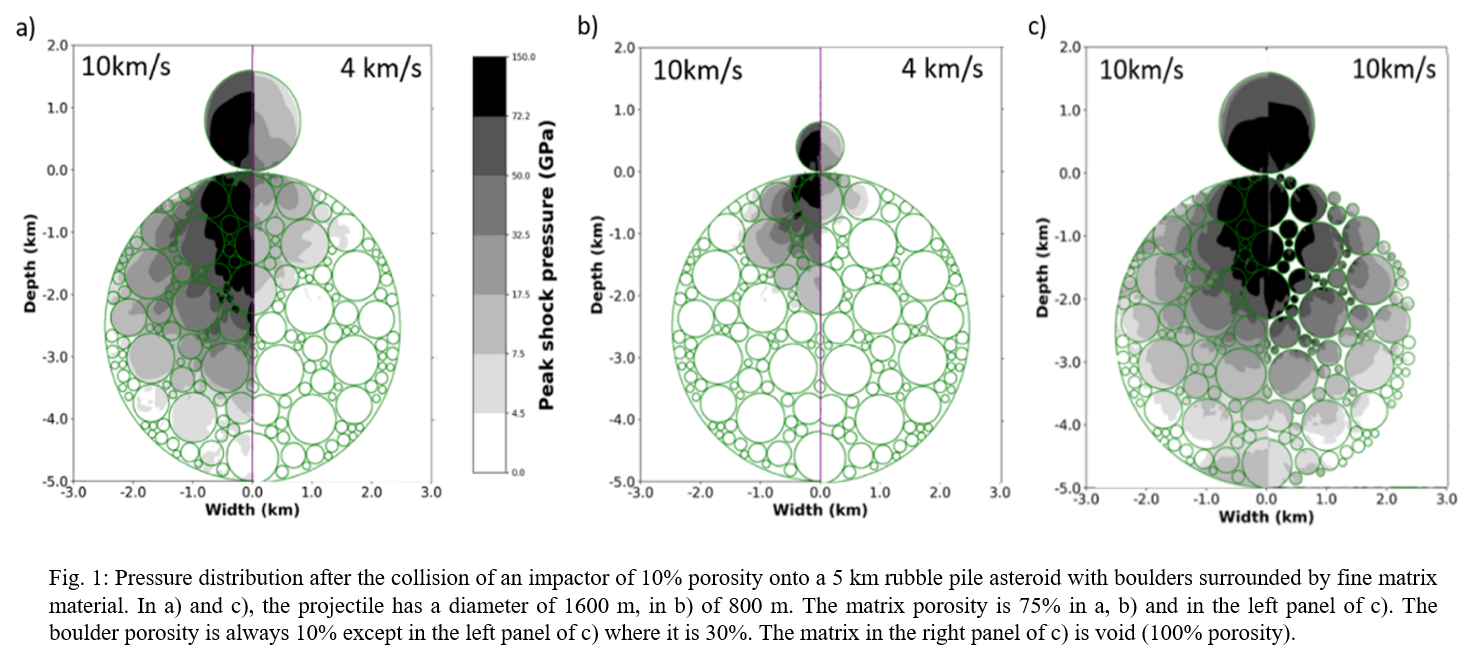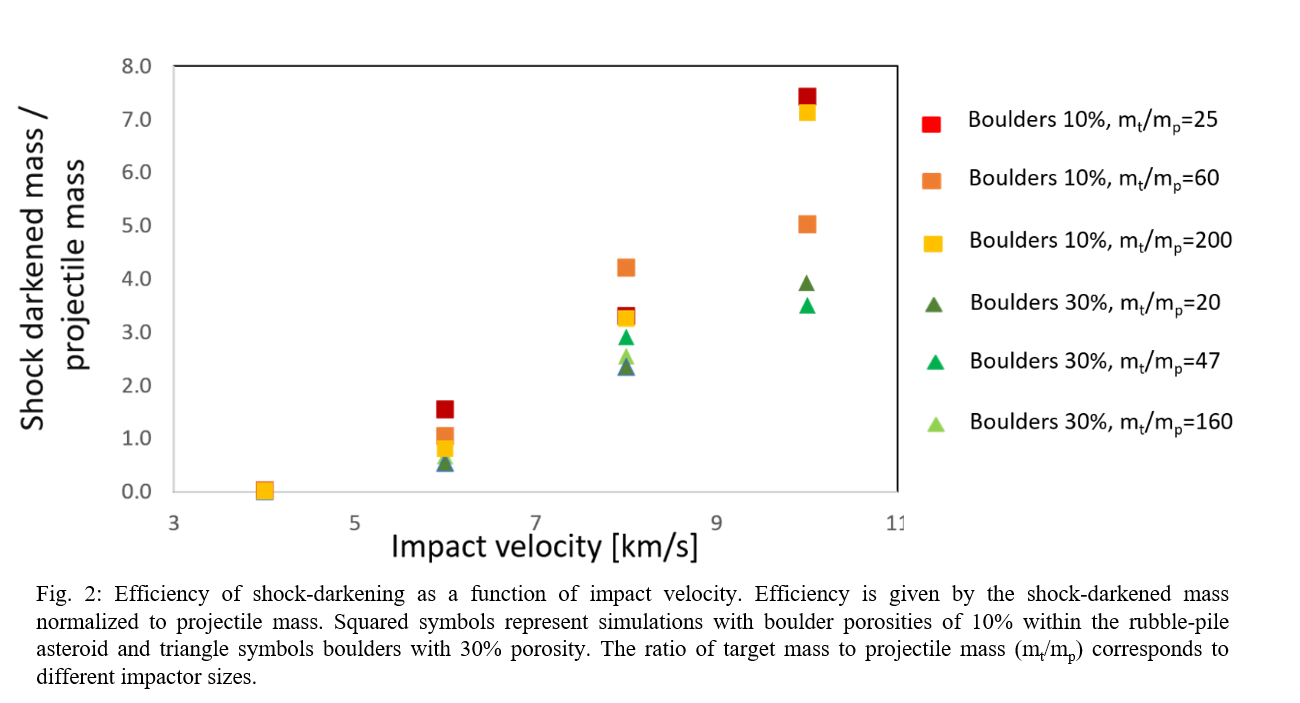- 1Department of Geosciences and Geography, University of Helsinki, Finland
- 2Museum für Naturkunde Berlin, Leibniz Institute for Evolution and Biodiversity Science, Germany (nicole.gueldemeister@mfn-berlin.de)
- 3Department of Geology, University of Tartu, Estonia Institute of Geology
- 4Institute of Geology of the Czech Academy of Sciences, Prague, Czech Republic
- 5Freie Universität Berlin, Institute for Geological Science, Germany
Introduction: Shock metamorphism in ordinary chondrites [1] is driven by impact events between asteroids. One effect of shock is the darkening of the lithology, which happens at two different stages of the shock intensity scale, at shock stage C-S7 (>70 GPa, whole rock melting, [1]) or between shock-stage 5 and 6 (40–60 GPa, metals and iron sulfides melt veins [2−7]). The darkening affects reflectance spectra of ordinary chondrites and, consequently, of asteroids. If an asteroid fragment of the S-complex asteroids is shock-darkened, its spectra will be similar to C/X-complex asteroids. This would affect the generally accepted spectroscopy-derived distribution of asteroids in the Main Asteroid Belt [7,8].
We investigate the impact conditions on rubble-pile asteroids in order to study the shock stage distribution and the mass of possibly shock-darkened asteroidal fragments. The distribution of porosity in rubble-pile asteroids depends on the internal structure [9]. The aim of the research is to highlight what type of rubble-pile asteroid collisions can explain the abundance of high shock stage materials [10] and the abundance of shock-darkened asteroidal fragments within the asteroid population.
Methods: We use the iSALE code [11] to simulate hypervelocity impact processes. We used the ε-α compaction model [11] for porosity, strength properties from [12] and an ANEOS for dunite to represent the material of the projectile and asteroid. We applied cylindrical-symmetry 2-D Eulerian gridwith Lagrangian tracers to study the distribution of peak shock pressures [13,14]. We apply numerical models of simplified rubble-pile structures of asteroids and study: a) The distribution of peak shock pressures (shock metamorphism). b) Quantification of shock-darkened material in the rubble-pile asteroid as well as in the escaping material. The model of a rubble-pile asteroid of 5 km in diameter is represented by several porous boulders of varying sizes surrounded by loose material. For the different impact scenarios, we varied the impact velocities (4−10km/s), the projectile diameters (800-1600m) and the porosities of the boulders (10−30%) as well as the porosity of the loose material (75−100%).
Results and discussion: The distribution of peak shock pressures strongly depends on both: impact velocity and projectile size (Fig.1a, b). Scenarios with cases considering higher boulder porosities (30%) only result in a small decrease of pressure (Fig. 1c, left panel) and thus lower shock stages are experienced as the shock wave is dampened by the compaction of porosity.
On the one hand porosity is responsible for an overall energy absorption but can on the other hand lead to localized pressure amplifications. Larger porosities of loose material (Figure 1c, right panel; here empty space) do not lead to significant differences compared to the case with porosities of 75% (Fig. 1a, left panel). We also observe that the rubble-pile asteroid is almost completely destroyed and porosity of the loose material is crushed out by the shock wave.

We also determined the efficiency of shock-darkening, which is defined as the shock-darkened mass in the rubble-pile asteroid normalized to the projectile mass (mt/mp). As shown in Fig. 2, the efficiency of shock-darkening increases significantly with increasing impact velocity and is dependent on the porosity of the boulders (compare squares and triangles in Fig. 2). For the most energetic impacts (large impactor and large impact velocities of 10 km/s) an efficiency of eight is reached, which correspond to about 30% of the asteroid being shock-darkened. Increasing the porosity of the boulders from 10 to 30% decreases the efficiency to about half the value. However, the effect remains stronger for larger impact velocity. By decreasing the impact velocity, the efficiency decreases linearly. For the lowest considered impact velocities shock-darkening is not efficient anymore.

In Fig. 3 we show the results from the investigation of the ejecta for different collision scenarios. For the largest impactor, almost the entire asteroid material is already escaping at 6 km/s (cp. red squares). For those cases up to 90% of the asteroid mass is escaping. Considering lower impact velocities, only for the larger impactor a sufficient amount (~50%) of material is escaping. An increase of boulder porosity has a pronounced negative effect on the amount of escaping mass: only a small percentage between 1% and 8% of the total asteroid mass will escape. Fig. 3b and c show the escaping shock-darkened mass with respect to total escaping mass (b) and to the total shock-darkened mass in the rubble-pile (c). Only a small portion of the total escaping mass is actually shock-darkened, for almost all collision scenarios less than 6% (Fig. 3b). It can be shown that for the most energetic impact between 15 and 45% of the shock-darkened mass in the rubble-pile asteroid are escaping from the asteroid (Fig. 3c).

To conclude, high levels of shock metamorphism in ordinary chondrites require impacts with high velocities (8−10km/s) and large projectiles in order to exceed at least 20% of target mass within the C-S5, C-S6 and C-S7 shock stage distribution in rubble-pile asteroids as well as a sufficient amount of shock-darkened escaping material.
Acknowledgments: Our thanks go to the iSALE developers. This work is supported by the Academy of Finland and the European Regional Development Fund and the programme Mobilitas Pluss (Grant No. MOBJD639).
References: [1] Stöffler et al. (2018) Meteorit. Planet. Sci., 53, 5-49. [2] Moreau J. et al. (2017) Meteorit. Planet. Sci., 52(11), 2375-2390. [3] Moreau J. et al. (2018). Phys. Earth Planet. In., 282, 25-38. [4] Moreau J. et al. (2019). Icarus, 332, 50-65. [5] Moreau J. and Schwinger S. (2020), 310, 106630. [6] Kohout T. et al. (2020) Astron. Astrophys., 639, A146. [7] Kohout T. et al. (2014) Icarus, 228, 78-85. [8] DeMeo F. E. and Carry R. P. (2014) Nature, 505, 629-634. [9] Housen and Holsapple (2003) Icarus, 163, 102-119. [10] Bischoff et al. (2018) Meteorit. Planet. Sci., 1-14. [11] Wünnemann K. et al. (2006) Icarus, 180, 514-527. [11] Asphaug et al. (1998) Nature, 393, 437-440. [12] Cremonese et al. (2012) Planet. Space Sci., 66, 147-154. [13] Elbeshausen et al. (2009) Icarus, 204, 716-731. [14] Elbeshausen and Wünnemann (2011) Proc. 11th Hypervelocity Impact Symposium 2010.
How to cite: Güldemeister, N., Moreau, J., Kohout, T., Wünnemann, K., and Luther, R.: High Pressure Shock Metamorphism in Rubble-pile Asteroids using Numerical Simulations, Europlanet Science Congress 2021, online, 13–24 Sep 2021, EPSC2021-468, https://doi.org/10.5194/epsc2021-468, 2021.

